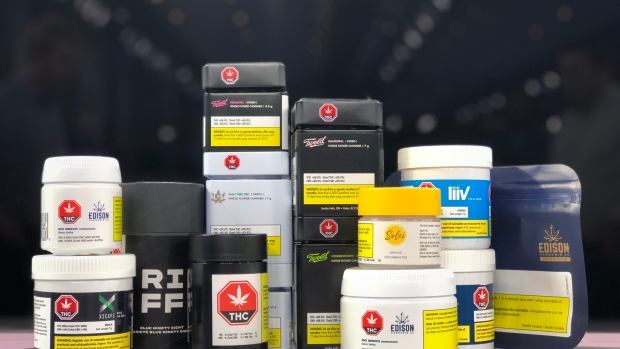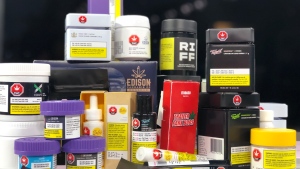Sep 21, 2018
The road from Ziplocs to collectible tins: How pot firms designed their products

It will be the very first thing a Canadian cannabis consumer will lay their hands on – right before they actually get high.
Pot producers looking to sell their products to Canadians when recreational use becomes legal in October have been on a months-long journey, designing the containers and packages that customers will see before they crack open their products.
Ziploc bags will no longer be the main receptacle to transport cannabis from producer to consumer. Today’s producers have spent hundreds of thousands of dollars and hired professional packaging design shops to devise packages that not only keeps cannabis fresh, but also adheres to Health Canada restrictions. Those rules seek to ensure that Canada’s new and legal marijuana products are tamper-proof, child-resistant and designed with muted colour tones and warning labels that are larger than the brand’s logo. The labelling is, however, less restrictive than tobacco packaging, which aims to restrict cigarette packs to a standard shape and size with "the same unappealing colour."
Ray Gracewood, chief commercial officer at Organigram Inc., said the company took the better part of a year to decide on its three brand offerings and the packaging designs for each one. The Moncton, N.B.-based company hired design agency Shikatani Lacroix to help build its packaging from the ground-up and determined it wanted to segment its cannabis into three segments – value, mainstream and premium offerings.
But ultimately, Organigram’s actual packaging has ended up relatively muted, mostly thanks to Health Canada’s regulations. The company’s cannabis flower products are mostly contained within a circular white jar resembling a hand cream container, while its premium Edison product will be packaged in a large blue envelope with a plastic zipper that seals to maintain freshness. Its pre-roll joints will be protected by a plastic insert and packaged in a small cardboard box similar in size to a candy bar.

“Over time, we understand that there will be some loosening on regulations,” Gracewood said in an interview with BNN Bloomberg. “[Health Canada’s] view was that they wanted to err on the side of caution. It’s still early days.”
Gracewood noted that as Organigram was developing its packaging, Health Canada’s so-called “plain packaging” guidelines were announced in March, briefly scuttling some of its existing concepts. The company had to go back to the drawing board and revisit how its Edison brand and “atomic leaf” logo were displayed to abide by Health Canada's mandate.
Organigram ended up making the logo slightly smaller than a red hexagonal warning sign, as well as a large yellow strip advising users of the risks of smoking cannabis. “It was an unfortunate reality for us, but we felt we got it right at the end of the day,” Gracewood said.
Meanwhile, Smiths Falls, Ont.-based Canopy Growth Corp. took nearly a year designing its metal, square-like containers clad with both plastic and tin, which the company hopes will stand out from other various brands. The containers have contoured edges that allow them to be stackable, said Amy Wasserman, Canopy’s head of recreational marketing, in an interview with BNN Bloomberg.
“We were always dreaming about tin and what tin means to people,” she said. “There’s the idea that you can keep your tin box and use it for a million things afterward. We wanted that notion of longevity and collectability.”
Wasserman added that Canopy’s design process took months of collaboration with its design team where some details were obsessed over and precision calipers were used to measure its packaging down to the millimetre.
“We had meetings three times a week, morning calls with as many as 50 people on the conference call to go over the minutia of the details of this packaging,” she said. “We had to work with production lines that had never dealt with cannabis before – so we had to spend time getting them installed and set up to make the packaging as automated as possible.”
But with all the different types of brands and strains that Canadians will be able to legally purchase on Oct. 17 and beyond, some may feel overwhelmed by the number of options. Enter Toronto-based company AHLOT, which identified early on that curious Canadians may not know if they prefer indica or sativa strains, and whether they would prefer to smoke cannabis containing a high percentage of THC (tetrahydrocannabinol) or CBD (cannabidiol).
AHLOT Chief Executive Greg Pantelic told BNN Bloomberg the company is working with several other brands distributed by producers such as Organigram and Emblem to provide consumers with five one-gram jars of cannabis flower so they can try before spending more money on something they may not like. The company’s “Discovery Series” box will come in “ultraviolet,” Pantone’s colour of the year in 2018, which Pantelic says he hopes will make its boxed product to stand out from other brands, similar to how Tiffany’s iconic blue stands out from other jewellers.
“People are going to have a tsunami of choice in October,” Pantelic said. “Compounding that is the packaging that will see some brands get lost in the shuffle. We wanted to try to stand out and offer something a little bit more unique.”
Cannabis Canada is BNN Bloomberg’s in-depth series exploring the stunning formation of the entirely new – and controversial – Canadian recreational marijuana industry. Read more from the special series here and subscribe to our Cannabis Canada newsletter to have the latest marijuana news delivered directly to your inbox every day.





